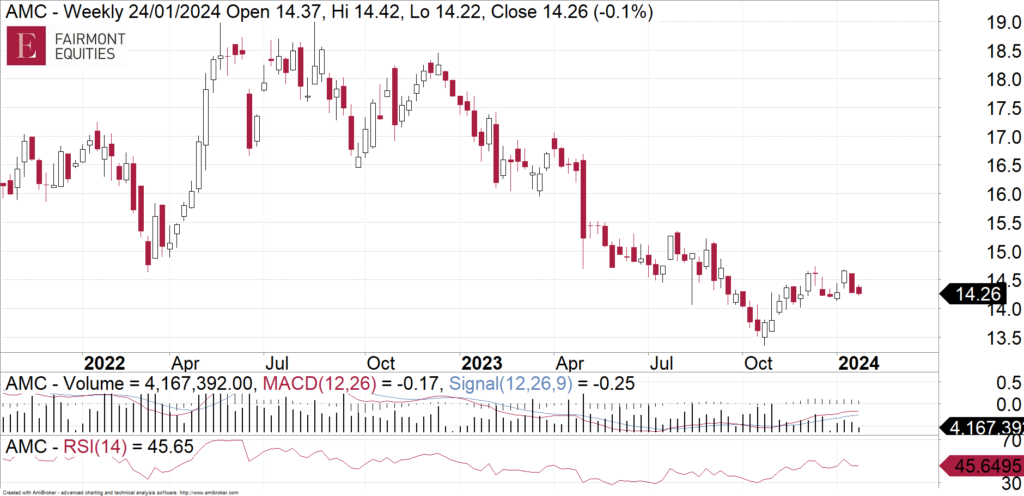Amcor (AMC:ASX) shares have endured a challenging 12 months, as earnings have been impacted by a confluence of several factors. These include lower volumes, limited pricing gains and input price pressure. We recently researched AMC in The Dynamic Investor, to assess whether there is scope for a re-rating from current levels.
About Amcor
Amcor is a global packaging manufacturer which has two operating divisions: Flexibles and Rigid Packaging (Rigids). The Flexibles division has operations in North America and South America, Europe and the Asia Pacific region. The Flexibles division includes the Bemis business (acquisition completed in June 2019) and accounts for >80% of group earnings. Key end market exposures are defensive sectors, namely food, healthcare, home & personal and tobacco. The Rigids division is mostly exposed to the beverage and personal care markets in North America and Latin America.
The revenue profile is highly skewed to defensive end markets, in particular the Food, Beverage and Healthcare segments.
Key Fundamental Drivers
Volumes Remain Weak – But Are Green Shoots Emerging?
Following on from a difficult FY23 period, group volumes continued to weaken for the three months to 30 September 2023 (1Q24). Consumer demand remained soft and customer destocking continuing. Flexibles volumes fell -8%, with volumes in both North America and Europe down significantly. The latter was mostly due to weakness in the healthcare, liquid beverage and coffee segments.
AMC highlighted that around 1/3rd of the volume weakness was driven by customer destocking, with the majority of the volume decline driven by weaker end-customer demand. We expect the rate of volume decline to improve through 2Q24 (-7%). This implies that group volumes in FY24 are likely to fall by ~2-3% compared to FY23. While the volume decline is due to continued destocking over FY24, commentary provided by AMC’s peers have shown a recovery in volumes and a reduced impact from destocking.
Can Pricing Offset Volume Pressure?
Pricing/mix continued to have a favourable impact on revenue growth in 1Q24 (+2%; 4Q23: +2%). A key challenge for AMC is whether it can continue to generate improved pricing/mix over FY24/25 as inflation moderates. Lower inflation levels reduce the extent to which general cost inflation can continue to be recovered.
Having said that, there are two factors that are likely to have an impact on pricing/mix over the short-term. Firstly, inflation remains high/persistent enough to affect demand levels. Secondly, there has been weakness in certain higher-value categories, such as healthcare and protein. In the healthcare category (which accounts for 14% of group sales), destocking is likely to continue for longer than other categories. This is because there was some prior customer stock build-up which is now unwinding.
Raw Material Prices Not a Major Headwind
The recent fall in Asian resin prices now see the latter relatively flat compared to FY23. Further, the average aluminium price for FY24 year-to-date (YTD) is 7% lower compared to FY23. While FY24 YTD average titanium dioxide prices are approximately flat in comparison to the FY23 average.
Merger & Acquisitions Remain on the Agenda – But Larger Deals May Challenging
Gearing in FY24 is expected to decline and free cashflow will be substantial. Accordingly, Merger & Acquisition opportunities remain a priority. Management comments suggest that its preferred use of free cash is for ongoing bolt-on acquisitions.
We expect that any further acquisitions are likely to be small and bolt-on in nature, much along the lines of acquisitions undertaken in FY23. The key reason underpinning this view is that competition regulators would likely block larger deals which overlap with AMC’s focus segments, given its high market share. One example is the recent sale of Constantia to One Rock Partners for €1,097m, which is likely to have presented regulatory hurdle for AMC. Notably, AMC has not completed a material deal since Bemis in mid-2019.
Fundamental View
AMC shares are currently trading on a 1-year forward P/E multiple of ~13.5x. Although this is at the bottom end of the trading range over the past two years, the shares still appear unattractive in the context of a modest EPS growth profile (in US$ terms) of +1% over FY23-26 on a CAGR basis. Further, any potential upside to the EPS growth profile is likely to be moderate. This is because the latter would rely heavily on a recovery in volume, as opposed to EPS-accretive Merger & Acquisitions, share buy-backs or increased cost-out activity.
Overall, we consider that investors are likely to want further evidence that the volume environment is improving/normalising before a re-rating can occur.
Charting View
AMC remains in a downtrend, but the past several weeks has seen it rise above some resistance. At best, we may see it move sideways for a few more months to build a base and then we can reassess the chart. A weekly close above $14.65 would start to look more constructive.

Michael Gable is managing director of Fairmont Equities.
Current share prices available here.
You can learn more about technical analysis in this article.
An 8-week FREE TRIAL to The Dynamic Investor can be found HERE.
Would you like us to call you when we have a great idea? Check out our services.
Disclaimer: The information in this article is general advice only. Read our full disclaimer HERE.
Like this article? Share it now on Facebook and Twitter!

